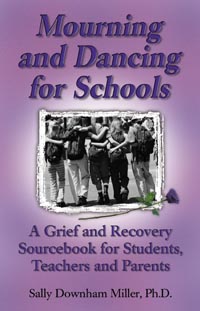
This inspiring work chronicles Sally Miller’s thirty-year journey of grief and recovery. A professional educator, Dr. Miller has constructed a book that leads readers through their grief as they read about hers. Along with her own moving story, Miller provides a framework that readers can use to identify and process their own grief.
Mourning and Dancing is designed for people who are trying to cope with any loss, even if years have passed since the loss or losses occurred. Its format includes true-life stories of the author’s family and individuals with whom she has walked through grief.
The vignette-style of presentation allows the newly aggrieved to read the book in small doses, a key ingredient for healing. Written after thirty years of learning, this touching book will show readers how to incorporate loss into their lives, how to live with the pain, and how to have hope and heal as a result of that brave endeavor.
Sally Downham Miller, led by her work in schools over the past fifteen years helping teachers, administrators, students and parents cope with the deaths of students and some faculty members, has written this guide for parents and teachers to help students deal with the loss of someone close to them. Because school is often the locus of students’ social lives, a death in this environment can have serious emotional consequences on school-age kids. This book will give parents and teachers a guide to help their children and students.
For the most part, schools have learned how to “do triage,” by calling in counselors and providing support through the funeral. While coping with the death, the immediate trauma and the funeral are important, this only allows a scab to form over the wound. The deep healing does not take place in three days or the first few weeks, and finding ways to help people grieve over time is substantially different. The people who work in schools see the effects of grief played out over time. They are the ones who watch helplessly the decline in student learning, health, and involvement. Teachers often are able to pinpoint the exact time when a student begins to decline or to withdraw or to “medicate” themselves against their pain. But, the work of helping students grieve in schools is ongoing: a week later, four months later, years later. It calls on the school to expand its role as a school family, providing a safe place for this work to take place. In this space students can learn to understand what is happening to them instead of only acting out feelings or repressing them, becoming depressed or hurting themselves.
When there is a death in a school, all of us want to do something, but no one wants to do the wrong thing. So usually very little is done. This book provides a plan for effective training on the interventions and on-going work of grief-support teams, that can help restore health and healing after counselors from the surrounding schools go back to their own jobs. Mourning and Dancing for Schools provides a model for this work, stories of the author’s interventions with children and schools, and instructions for training a team of people to help students learn to cope with loss. It is a training manual for those in our schools who want to do grief work with students, including teachers, administrators, parents, and community members. As a helpful addenda to the book, the website www.kidsgrieve.org will have downloadable worksheets for grief models that educators can use when working with kids in crisis.
Author Highlights
Sally Downham Miller, Ph.D., has been a writer, speaker, support-group leader, hospice trainer and consultant in the area of grief and loss for twenty years. Simultaneously, her career in education has been as a teacher, director of special education, university professor, school principal and educational specialist for two state departments of education. Currently, she is the director of a nonprofit grief-recovery organization, Mourning and Dancing, Inc. and the author of Mourning and Dancing: A Memoir of Grief and Recovery. She is the mother of two grown children and the grandmother of three little boys. She lives in Indiana and New York City with her husband, author and speaker Dr. Will Miller with whom she often works and travels.